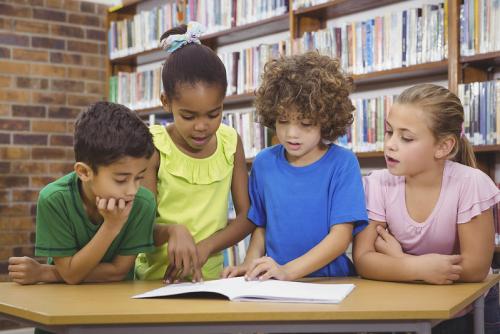 What better place to foster a love of reading and engage children in a variety of literacy activities than in out-of-school time (OST) programs? Research shows that OST programs can support the development of and excitement about literacy in a setting where children feel comfortable.
What better place to foster a love of reading and engage children in a variety of literacy activities than in out-of-school time (OST) programs? Research shows that OST programs can support the development of and excitement about literacy in a setting where children feel comfortable.Between August 2019 and December 2023, the National Institute on Out-of-School Time (NIOST) partnered with OST programs in the Philadelphia Out-of-School Time Literacy and Quality Improvement Initiative (OSTLit), funded by the William Penn Foundation, to create and sustain literacy-rich environments (LRE). Our aim was to help programs embed literacy into everyday practices so children in kindergarten through third grade could engage with literacy activities in a new way.
NIOST approached this work from a program improvement perspective, meeting programs where they were in understanding the elements of LREs and then providing the necessary training, coaching, and instructional resources to support programs on an improvement pathway. Ongoing support and activities were designed to be predictable, easy-to-access, and meant to put light-touch literacy practices into action right away. OST program staff participated in a monthly learning cycle that included a brief training video on a light-touch literacy practice, implementing the practice in their program, check-in meetings with a quality and/or literacy coach, and community of practice (CoP) meetings with peers.
Beyond the OSTLit Initiative, providing LREs for children to practice and build literacy skills outside of school has long been a priority for the City of Philadelphia and the William Penn Foundation. Through their broader LRE Initiative, various partners set out to provide access to literacy and playful learning in informal learning spaces such as bus stops, museums, libraries, medical offices, laundromats, playgrounds, and more. The recent brief from The Learning Agenda (2024), Philadelphia as a Literacy-Rich Environment: Unlocking Potential and Creating Change, describes the approaches, environmental conditions, and funding implications for taking literacy-rich environments to scale in other communities.
The Learning Agenda convened representatives from organizations funded by the LRE Initiative to gather insights from the project in order to help others create city-wide approaches to address literacy.
The group highlighted five main conditions to create and sustain LREs, as well as recommendations for funders.
The conditions that can help scale an initiative such as the LRE included (1) be inclusive of all the potential places and people that can contribute to a literacy-rich ecosystem, (2) activate literacy-rich environments in the places and spaces where children and their caregivers naturally are or want to be, (3) co-create literacy-rich environments with family and community members, (4) embrace a broad range of outcomes, and (5) maximize collaboration, networking, and shared learning. Funders can contribute to the scalability of these initiatives by focusing on engaging the community in planning and evaluation processes, bringing partners focused on the same issue together to collaborate, and recognizing that there is room for a multitude of strategies to support literacy.
Patricia McGuiness-Carmichael, M.S.W., is a research associate at NIOST. She has an extensive background in youth development and family engagement practice, research, and evaluation.
Learn more about how NIOST can help your OST program create and sustain a literacy-rich environment. Contact us to get started.


 The fifth-grader’s voice was full of emotion as he shouted, “That’s not fair! What a mean thing to do!”
The fifth-grader’s voice was full of emotion as he shouted, “That’s not fair! What a mean thing to do!”